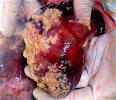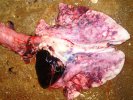Mulberry heart disease
Vitamin E or selenium deficiency presents with sudden death in recently weaned piglets.
Alternative names: Vitamin E deficiency, Selenium deficiency
Information
Vitamin E and selenium are found in various feed ingredients such as vegetable oils, grains, and green plants. Sometimes problems arise when using polyunsaturated fats as an energy source as they destroy vitamins in the diet. Vitamin E and selenium serve as antioxidants and are needed for optimum functioning and metabolism of the nervous, muscular, circulatory, and immune systems. The recommended levels are 100 IU/kg in the ration of growing pigs and 60 IU/kg in the ration for pigs in the finishing stage. These levels are probably higher than what is needed for maximum growth (levels could be up to 50% lower). When polyunsaturated fatty acids are used in the diet, add 3 IU of vitamin E per gram of polyunsaturated fatty acids. Pigs with vitamin E or selenium deficiency are very susceptible to iron intoxication.
Symptoms
Nursing piglets, sows, and fattening pigs
- Not seen.
Transition
- Sudden death.
- Increased levels of other concurrent diseases.
Causes / Contributing Factors
- The diet, if high in fat.
- Vitamin A deficiency.
- Vitamin E and/or selenium deficiency.
- Fast growth can be a contributing factor.
- A high animal density may predispose animals.
- Grains with a high moisture content, stored at high temperatures and with fungal growth may have low levels of vitamin E.
Diagnosis
- For a precise diagnosis, a histological examination of the liver and heart must be done.
- Large amounts of fluid around heart and lungs.
- Hemorrhagic and pale areas in the heart muscle.
- Fluid in the abdomen with bits of fibrin.
- Areas of pale muscle (necrosis) particularly in the lumbar and hind leg muscles, which contain excess fluid.
- If the liver is affected, it will appear enlarged and mottled, with hemorrhagic areas mixed with pale areas.
Control/Prevention
- If a population is at risk, all pigs must be injected with vitamin E / selenium or it can be given through water.
- Vitamin E levels should be increased.
Atlas of pathology
See images in the Altlas related to Mulberry heart disease





